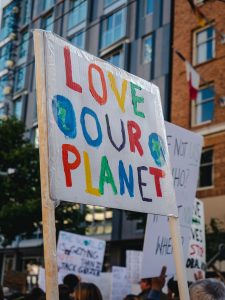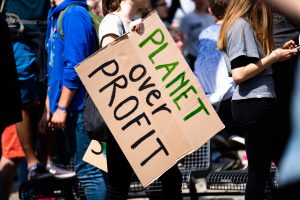Philipp Köhn, University of Siegen, Chair of Entrepreneurship & Family Business
Abstract
In times of omnipresent discussions on humans caused climate change, each individual is encouraged to behave and act in an environmental-friendly way to keep our planet viable. This is especially valid for the business context, where profit and growth are usually having top priority and social and ecological consequences of economizing are often neglected. However, businesses can have a crucial impact on climate change by reducing waste and CO2 emissions or by steering how we consume. Considering this, sustainable entrepreneurship, which follows principles of the so-called triple bottom line by equally aiming at monetary, social and ecological gains, might be the present and future way of doing business. Thus, the purpose of this blog entry is to shed light on different aspects of sustainable entrepreneurship. Firstly, it defines sustainable entrepreneurship to create a deeper understanding of this concept and to distinguish it from other forms of entrepreneurship. Therefore, literature on conventional, environmental, social and sustainable entrepreneurship is analyzed, compared and synthesized. Secondly, social and ecological market failures as external drivers of sustainable entrepreneurship are investigated. By researching topic-related literature and by presenting four real-life cases of sustainable enterprises, it can be shown how social and ecological market failures build external drivers of sustainable entrepreneurship. Findings reveal that social and ecological market failures occur since markets are imperfect. These market imperfections imply the exploitation of public goods, the existence of negative externalities, monopoly power, inappropriate government interventions, information asymmetries, firm’s inefficiency, and flaw pricing mechanisms. Social and ecological market failures that arise from such market imperfections provide entrepreneurial opportunities often being initial impulses that externally drive sustainable entrepreneurship.
Can you hear it? The call for sustainable entrepreneurship gets louder
While you are going to begin reading this blog entry, please first think about how you would answer the following question: Do you trust research? For me, a nascent researcher, the answer definitely is a “yes”. However, when looking at current discussions in policy, economy, media, and society, it seems that a not-insignificant number of persons would answer the opposite. Otherwise, it cannot be explained why the German noun of the year 2019 has been “climate hysteria” („Klimahysterie“ ist Unwort des Jahres 2019 | DW | 14.01.2020“, o. J.). This obviously illustrates that many people disagree with the prevailing consensus of climate researchers and experts claiming that global warming is a real phenomenon caused by humans and not just a conspiracy as many people believe. Thus, the researchers and experts warn about the consequences of the changing climate for the planet and humankind and declare it as the main challenge of our time.

Contrary to mentioned distrust in research, there is a group of mainly young people uniting behind the science by sharing the consensus of climate research that global warming is caused by humans and for sure one of the main challenges of our time. This group, better known as the Fridays for Future movement, demonstrates every Friday against increased CO2 emissions, pollution, and irresponsible contact with our natural environment. The aim of the Fridays for Future demonstrations is to create a general awareness of global warming and to signal a paradigm shift, in which economic growth and profits are not any longer the top priority of politics and businesses as this way of economizing dramatically harms our environment. They rather request for a post-growth economic model (Kallis, Kerschner, & Martinez-Alier, 2012; Victor, 2019) in which each individual behaves and act more socially and sustainably in order to keep our planet viable („Fridays for Future“, o. J.).
The way the Fridays for Future activist demand for this change is impressive: They are extremely dedicated and express their demands with such a loud voice no one can ignore. Apparently, these demonstrations against human-caused global warming do not have missed their objective: The topic of climate change is by now omnipresent and a fixed component in political discussions, the media, and society. Even in the business context, where usually profit and growth had top priority, climate change appears to be a big issue. It goes that far that climate change is already perceived as the biggest threat for businesses (Harder, o. J.)..

Thus, it is not surprising that at the recent World Economic Forum 2020 in Davos, where the political and economic world leaders come together to discuss the world’s future outline, the concerns of the Friday for future movement are considered. This was leading to the fact that the containment of global warming was one crucial point on the agenda of the recent World Economic Forum in Davos. In this context, one of the most discussed topics was how to establish a more social and more sustainable economy („Social entrepreneurs meet at World Economic Forum in Davos | Business| Economy, and finance news from a German perspective | DW | 21.01.2020″, o. J.; „Why all companies should be sustainable | World Economic Forum“, o. J.; „Why Sustainability Was The Star At Davos 2020″, o. J.)
Considering the essential role business units can play to preserve our planet’s health, an increasing number of protagonists, who recognized that previous business models mainly based on profits and growth might destroy the planet, have decided to start their own businesses that are not primarily aiming at economic goals. They rather focus on social and ecological aspects, besides monetary profits, and combine these three facets to the so-called triple bottom line in their business models (Belz & Binder, 2017; Binder & Belz, 2015). This process of starting and running a firm respecting the triple bottom line is labeled as sustainable entrepreneurship. This blog entry sheds light on this alternative way of running a business by firstly defining what sustainable entrepreneurship is and what it is not. Secondly, it digs deeper into the motivation of sustainable entrepreneurs by investigating social and ecological market failures as external drivers of sustainable entrepreneurship. Therefore, the literature on conventional, social, environmental and sustainable entrepreneurship is analyzed and synthesized. Moreover, four real-life cases illustrating how mentioned market failures can be initial impulses and thus drivers of sustainable entrepreneurship, are presented.
What sustainable entrepreneurship actually is and what it is not
As already mentioned, the sustainability concept is gaining more and more relevance in each area of our life. This is also true for the entrepreneurship and management research field. In recent years the research interest in sustainable entrepreneurship has increased (Binder & Belz, 2015; Gast, Gundolf, & Cesinger, 2017; Thompson, Kiefer, & York, 2011). Due to this grown relevance of this topic, a definition of what sustainable entrepreneurship is and what it is not appears to be necessary for a further and deeper understanding of it. In literature, sustainable entrepreneurship is defined as “…the recognition, development and exploitation of opportunities by individuals to bring into existence future goods and services with economic, social and ecological gains.” (Belz & Binder, 2017, p. 2). Sustainable entrepreneurship finds its origins in conventional entrepreneurship, environmental entrepreneurship and social entrepreneurship (Binder & Belz, 2015; Schaltegger & Wagner, 2011). Although many aspects are linking sustainable entrepreneurship to these forms of entrepreneurship, there are differences observable: Conventional entrepreneurship, defined as the opportunity exploitation to create innovations in various forms (Shane & Venkataraman, 2000), is considered to be a one-dimensional process by primarily focusing on economic gains like financial returns and profits (Davidsson & Wiklund, 2001; Gibb, 1996; Shane, 1996). In contrast, environmental entrepreneurship and social entrepreneurship both pursue a double-bottom line in their business models. Environmental entrepreneurship, also labeled as ecopreneurship, is “…the process of discovering, evaluating, and exploiting economic opportunities that are present in environmentally relevant market failures.” (Dean & McMullen, 2007, p. 58) and aims at economic and ecological value creation. Social entrepreneurship is defined “…as a process involving the innovative use and combination of resources to pursue opportunities to catalyze social change and/or address social needs…” (Mair & Martí, 2006, p. 37) and grasps at economic and social goals. Comparing these three forms of entrepreneurship with sustainable entrepreneurship, it gets obvious that all of them imply a central aspect of entrepreneurship by basing on the recognition, development, and exploitation of opportunities (Davidsson & Wiklund, 2001; Gibb, 1996; Shane, 1996; Shane & Venkataraman, 2000). However, sustainable entrepreneurship distinguishes itself from the others by emphasizing the triple bottom line involving the interplay between economic, social and ecological goals (Belz & Binder, 2017; Binder & Belz, 2015).
Since we now know, where sustainable entrepreneurship finds its origins and how it distinguishes itself from related concepts, we can have a closer look at its definitions given in the literature so far. Basing on them, a working definition of sustainable entrepreneurship for the blog entry is formulated at the end of this passage. Referring to recent research on sustainable entrepreneurship, various definitions can be found. The heterogeneity among the definitions can be traced back to the multidisciplinarity of previous research (Binder & Belz, 2015). Cohen and Winn (2007) e.g. define sustainable entrepreneurship as a process in which an individual examines how an opportunity can be discovered, developed and exploited in order to create innovative goods and services that have an impact on economic, psychological, social and environmental aspects. Dean and McMullen (2007) suggest that opportunities leading to sustainable entrepreneurial activities are caused by market failures harming the environment. Beyond this, sustainable entrepreneurship might transform such failed markets into more environmentally and socially focused ones (Hockerts & Wüstenhagen, 2010). Others define sustainable entrepreneurship as the discovery, creation, and exploitation of opportunities to create innovations that promote sustainable development regarding the natural and communal environment (Pacheco, Dean, & Payne, 2010; Patzelt & Shepherd, 2011). As these definitions show, a range of different definitions is present in literature, which, as already mentioned, can be explained by the multifaceted disciplines investigating sustainable entrepreneurship. Nevertheless, certain patterns of defining sustainable entrepreneurship can be identified enabling to formulate the following working definition of sustainable entrepreneurship for this blog entry:
Sustainable entrepreneurship is the process of recognizing, developing and exploiting opportunities, caused by social and ecological market failures, resulting in innovative products, services, and processes that follow the triple bottom line by equally creating economic, social and sustainable gains.
Why are they doing this? Market failures as external drivers of sustainable entrepreneurship

Considering the above-mentioned working definition, one crucial aspect of sustainable entrepreneurship is to pursue the triple bottom line. This makes the process of sustainable entrepreneurship quite complex as all three economic, social and ecological aspects need to be balanced acceptably. As a consequence, financial losses are often accepted in order to comply with social and ecological goals (Cohen, Smith, & Mitchell, 2008). Moreover, sustainable entrepreneurs face on the one hand challenges of financing their business as the majority of investors strive for monetary revenues instead of social or ecological value creation and on the other hand, they are confronted with barriers to market entry as a critical mass of consumers first needs to be convinced to buy their products and services (Linnanen, 2002). Hearing all these obstacles to sustainable entrepreneurship, the question, why certain individuals decide to start and run a business with a triple bottom line business model, is more than legitimated to raise.
The answers to this question are, like the motivational factors of sustainable entrepreneurship (Keogh & Polonsky, 1998), manifold. Besides internal psychological factors such as personal characteristics, values and intrinsic motivation (Gliedt & Parker, 2007; Kirkwood & Walton, 2010), there are external drivers such as legal regulations, institutional factors, public concerns and expected competitive advantages (Gast, Gundolf & Cesinger, 2017; Meek, Pacheco, & York, 2010) encouraging conventional entrepreneurs to become sustainable entrepreneurs. Since the investigation of mentioned factors driving sustainable entrepreneurship would definitely be beyond the scope of this blog entry, I will shed light on social and ecological market failures as external drivers of sustainable entrepreneurship. Therefore, I analyze previous literature and present four real-life cases in which social and ecological market failures have been the initial impulse to start a sustainable enterprise.
To grasp how social and ecological market failures drive sustainable entrepreneurship, we should again take a closer look at our definition of sustainable entrepreneurship: The aspect of the triple bottom line has already been made a subject of our discussion. However, we find another decisive element in our definition of sustainable entrepreneurship, which is the recognition and exploitation of opportunities. Before entrepreneurs, regardless if they are conventionally, socially, environmentally or sustainably driven, start their venture, they have to identify an entrepreneurial opportunity (McMullen & Shepherd, 2006; Shepherd, McMullen, & Jennings, 2007). According to previous literature, these opportunities often arise out of social or ecological problems leading to market failures (Belz & Binder, 2017; Cohen & Winn, 2007; Dean & McMullen, 2007; Gast et al., 2017) that are constituting personal, communal and environmental threats (Patzelt & Shepherd, 2011). Market failures are basing on the suggestion that markets are imperfect (Cohen & Winn, 2007; Dean & McMullen, 2007). Dean and McMullen (2007) e.g. name five reasons causing market failures: (1) Public goods are inconsiderately exploited. International waters, for example, are not owned by any nation. Thus, no legal regulations exist here. The fishing industry utilizes this legal vacuum and commercializes the oceans by overfishing them instead of preserving this biosphere and inherent resources; (2) Negative externalities exist meaning that firm’s actions often have no or even a negative impact on other parties; (3) Firms having monopoly power do not feel any pressure of direct competitors. Thus, there is no urge for such firms to change their way of economizing like integrating environmental-friendly technologies into internal processes; (4) Inappropriate government interventions such as subsiding businesses, which extract natural resources (e.g. forest cleaning or oil extraction) can harm the natural environment; (5) Information asymmetries (Akerlof, 1970) between firms, suppliers and customers are present and can result in moral hazards (Holmstrom, 1979). In line with this, Cohen and Winn (2007) also argue that market failures are antecedents for entrepreneurial opportunities and thus driving sustainable entrepreneurship. Like Dean and McMullen (2007), they identified externalities and information asymmetries as potential market failures. Furthermore, they consider firms’ inefficiency in the allocation and use of resources leading to avoidable waste. Additionally, flawed pricing methods implying that natural resources are undervalued and underpriced is another aspect proposed in their canon of market failures (Cohen & Winn, 2007). Based on these problems and market failures, sustainable entrepreneurs are incited to find and to exploit opportunities resulting in the development of social or ecological products and services (Kirkwood & Walton, 2010).
The suggestion that social and ecological market failures are antecedents for entrepreneurial opportunities is also supported by Belz and Binder (2017). In their qualitative study, they analyzed the process of sustainable entrepreneurship. Therefore, they employed a multiple case study (Eisenhardt, 1989; Yin, 2018) and conducted interviews with four sustainable enterprises. Their findings show that for each investigated case market failures emerged through social (e.g. low incomes or corruption) or ecological problems (e.g. overconsumption, glacial melting or pollution) offered an opportunity to start a business with a triple bottom line business model (Belz & Binder, 2017). In the following, I will present each of the four cases to demonstrate how mentioned market failures drive sustainable entrepreneurship.
Fairmondo
In 2013, Felix Weth introduced Fairnopoly, which is now called Fairmondo, to the online retailing market. With Fairmondo, the founder created a fair and transparent alternative to the present market leaders eBay and Amazon in online retailing. The principles of this platform imply that private individuals can sell their products without any fees and that the fees for commercial sellers are fair and transparent („Fairmondo“, o. J.). During its internship at Transparency International, Felix Weth identified corruption and monopolistic market structures (Dean & McMullen, 2007) as pillars of social problems and market failures worldwide. Thus, he decided to start the fair and transparent user-driven online market Fairmondo (Belz & Binder, 2017), which is an alternative platform to the monopolistic market leaders in the online retailing industry.
Coffee Circle

Coffee Circle was founded by Martin Elwert, Robert Rudnick and Moritz Waldstein. The firm entered the food and beverage market in 2010. The aim of Coffee Circle is to sell and deliver the world’s best coffee without exploiting the producers from countries like Ethiopia, Kenia or Columbia. The founders rather pay them fair wages as they are convinced that higher financial incomes encourage the producers to adhere to their traditional and ecological way of cultivating coffee, which is the key to top quality coffee (Coffee Circle, o. J.) . The idea to start Coffee Circle emerged when two of the founders traveled to Ethiopia. During their stay, they realized that Ethiopian coffee farmers are confronted with low incomes. While they barely are not able to feed their families or send their children to educational institutions, coffee retailers make peak sales. Here, we have a good example of negative externalities as the behavior of one party has a negative influence on the other ones. Moreover, flawed pricing mechanisms can be observed in this setting as the labor of the coffee farmers in Ethiopia is undervalued (Cohen & Winn, 2007; Dean & McMullen, 2007). The recognition of unfair wages as a social market failure offered an opportunity and motivated the founders of Coffee Circle to solve this problem. By establishing a direct link between the Ethiopian coffee farmers and the consumers without any intermediaries and retailers, fair incomes for the producers can be guaranteed (Belz & Binder, 2017) and the traditional and ecological way of cultivating coffee, which is the fundament of top quality coffee, can be ensured.
Globe Hope
Globe Hope is a Finnish fashion business that designs bags, accessories and cosmetic products. It was established in 2003 by its founder Seija Lukkala. The resources Globe Hope uses to produce its goods are recycled and leftover materials or pure northern ingredients („Information about Globe Hope“, o. J.). The founder Seija Lukkala can refer to manifold experiences in the clothing and fashion industry. In her former business, she was confronted with the negative facets of the fast-fashion industry including overconsumption and waste production.

Especially, the high amount of waste through the production extremely frustrated her. On the account of this ecological market failure, she took the decision to start Globe Hope. The aim of Globe Hope is to “…make lovable out of abandoned and forgotten.” („Products“, o. J.) and by doing so to address the issues of the fast-fashion industry and textile waste. In times of fast-fashion, prices for clothes are extremely low (flawed pricing mechanisms), which encourages consumers to frequently buy new ones. The increased demand of the consumers boosts the production of clothes leading to pollution (negative externalities) and high amounts of waste (inefficient firms). By upcycling abandoned materials and clothes and by demanding higher prices for its products (backpacks start at 139,00€), Globe Hope wants to crack down on waste production and overconsumption, which are consequences of the prevailing fast-fashion industry.
Polarstern
Less bullshit, more real! This is the credo of Polarstern’s founders Jakob Assmann, Florian Henle, and Simon Stadler. The green power supplier Polarstern was introduced to the energy market in 2011. By providing renewable energies for private households, Polarstern wants to revolutionize the energy sector. And since all of this is not enough, Polarstern also pursues a general rethinking of the way we economize, which should be more collaborative instead of competitive („Ökostrom und Ökogas von Polarstern“, o. J.). The initial impulse for starting Polarstern was the personally experienced consequences of climate change. While hiking in the mountains, Jakob Assmans observed the retreat of glaciers. Since CO2 intensive energies generated through oil or coal are the main reasons for climate change(Stocker & Intergovernmental Panel on Climate Change, 2013), this ecological market failure was a driver to produce CO2 neutral biogas and green electricity. Whereas green electricity was widely available in the German energy market, biogas for heating households was not offered in 2010 and thus a market worth entering (Belz & Binder, 2017).
As the presented cases reveal, market failures basing on social or ecological problems often are antecedents of opportunities that externally drive sustainable entrepreneurship.
Takeaways of this blog entry
Congratulations! Since you are reading the last passage of this blog entry, you now know what sustainable entrepreneurship is and how social and ecological market failures externally drive it. With this knowledge, you are able to enter various discussions on this topic or just showing off in front of your colleagues, friends, and family, if needed. To ensure that this knowledge will be sustainably saved on your anatomical hard disk, I will briefly summarize the essence of this blog entry in the following for you:
In times of global warming, the climate is changing. Through political discussions, media’s and society’s interest and the Fridays for Future movement the topic of climate change is omnipresent. It also already has entered the business context. Apparently, here a rethinking of how to economize is taking place. Instead of making business as usual by focusing on profit and growth as a top priority, a more social and ecological way of doing business is demanded in order to keep our planet viable. Doing business in such a way with a business model combining monetary, social and ecological gains in the so-called triple bottom line is a central aspect of sustainable entrepreneurship. The concept of sustainable entrepreneurship is derived from conventional entrepreneurship, environmental entrepreneurship or ecopreneurship, and social entrepreneurship. In this blog entry, sustainable entrepreneurship is defined as the process of recognizing, developing and exploiting opportunities, caused by social and ecological market failures, resulting in innovative products, services, and processes that follow the triple bottom line by equally creating economic, social and sustainable gains. In general, sustainable entrepreneurship drives on many factors. Besides diverse internal and external factors, social and ecological market failures can externally drive sustainable entrepreneurship. These failures offer opportunities to start a business solving social and ecological problems by focusing on the triple bottom line. Such market failures are caused by imperfect markets implying e.g. negative externalities, flawed pricing mechanism, inefficient firms or monopoly power. By looking at four real-life cases (Fairmondo, Coffee Circle, Globe Hope, and Polarstern), in which social market failures (unfair wages, corruption, and monopolistic structures) and ecological market failures (waste, overconsumption, and pollution) have offered an entrepreneurial opportunity and thus have been the initial impulse to start a sustainable enterprise, it could be shown how social and ecological market failures can be external drivers of sustainable entrepreneurship.
References
Akerlof, G. A. (1970). The Market for Lemons: Quality Uncertainty and the Market Mechanism. Quarterly Journal of Economics, 84, 488–489.
Belz, F. M., & Binder, J. K. (2017). Sustainable Entrepreneurship: A Convergent Process Model: Sustainable Entrepreneurship: A Convergent Process Model. Business Strategy and the Environment, 26(1), 1–17.
Binder, J. K., & Belz, F.-M. (2015). Sustainable entrepreneurship: What it is. In P. Kyrö (Hrsg.), Handbook of Entrepreneurship and Sustainable Development Research (S. 30–66).
Coffee Circle. (o. J.). Unsere Story: Wofür steht Coffee Circle? Abgerufen 5. März 2020, von Unsere Story: Wofür steht Coffee Circle? | Coffee Circle website: https://www.coffeecircle.com/de/e/story
Cohen, B., Smith, B., & Mitchell, R. (2008). Toward a sustainable conceptualization of dependent variables in entrepreneurship research. Business Strategy and the Environment, 17(2), 107–119.
Cohen, B., & Winn, M. I. (2007). Market imperfections, opportunity and sustainable entrepreneurship. Journal of Business Venturing, 22(1), 29–49.
Davidsson, P., & Wiklund, J. (2001). Levels of Analysis in Entrepreneurship Research: Current Research Practice and Suggestions for the Future. Entrepreneurship Theory and Practice, 25(4), 81–100.
Dean, T. J., & McMullen, J. S. (2007). Toward a theory of sustainable entrepreneurship: Reducing environmental degradation through entrepreneurial action. Journal of Business Venturing, 22(1), 50–76.
Eisenhardt, K. M. (1989). Building Theories from Case Study Research. Academy of management Review, 14(4), 532–550.
Fairmondo. (o. J.). Abgerufen 5. März 2020, von https://www.fairmondo.de/ueber_uns
Fridays for Future. (o. J.). Abgerufen 5. März 2020, von https://fridaysforfuture.de/
Gast, J., Gundolf, K., & Cesinger, B. (2017). Doing business in a green way: A systematic review of the ecological sustainability entrepreneurship literature and future research directions. Journal of Cleaner Production, 147, 44–56.
Gibb, A. A. (1996). Entrepreneurship and Small Business Management: Can We Afford to Neglect Them in the Twenty-first Century Business School? British Journal of Management, 7(4), 309–321.
Gliedt, T., & Parker, P. (2007). Green community entrepreneurship: Creative destruction in the social economy. International Journal of Social Economics, 34(8), 538–553.
Harder, A. H., Amy. (o. J.). Climate change becomes a top business threat. Abgerufen 10. Februar 2020, von Axios website: https://www.axios.com/climate-change-business-threat-467376e9-99a6-47e8-bffa-954c4a72c098.html
Hockerts, K., & Wüstenhagen, R. (2010). Greening Goliaths versus emerging Davids—Theorizing about the role of incumbents and new entrants in sustainable entrepreneurship. Journal of Business Venturing, 25(5), 481–492.
Holmstrom, B. (1979). Moral Hazard and Observability. The Bell Journal of Economics, 10(1), 74.
Information about Globe Hope. (o. J.). Abgerufen 5. März 2020, von https://www.globehope.com/information
Kallis, G., Kerschner, C., & Martinez-Alier, J. (2012). The economics of degrowth. Ecological Economics, 84, 172–180.
Keogh, P. D., & Polonsky, M. J. (1998). Environmental commitment: A basis for environmental entrepreneurship? Journal of Organizational Change Management, 11(1), 38–49.
Kirkwood, J., & Walton, S. (2010). What motivates ecopreneurs to start businesses? International Journal of Entrepreneurial Behavior & Research, 16(3), 204–228.
„Klimahysterie“ ist Unwort des Jahres 2019 | DW | 14.01.2020. (o. J.). Abgerufen 5. März 2020, von DW.COM website: https://www.dw.com/de/klimahysterie-ist-unwort-des-jahres-2019/a-51994639
Linnanen, L. (2002). An Insider’s Experiences with Environmental Entrepreneurship. Greener Management International, 2002(38), 71–80.
Mair, J., & Martí, I. (2006). Social entrepreneurship research: A source of explanation, prediction, and delight. Journal of World Business, 41(1), 36–44.
McMullen, J. S., & Shepherd, D. A. (2006). Entrepreneurial Action And The Role Of Uncertainty In The Theory Of The Entrepreneur. Academy of Management Review, 31(1), 132–152.
Meek, W. R., Pacheco, D. F., & York, J. G. (2010). The impact of social norms on entrepreneurial action: Evidence from the environmental entrepreneurship context. Journal of Business Venturing, 25(5), 493–509.
Ökostrom und Ökogas von Polarstern. (o. J.). Abgerufen 5. März 2020, von Polarstern—100% Ökostrom und 100% Ökogas website: https://www.polarstern-energie.de/ueber-uns/
Pacheco, D. F., Dean, T. J., & Payne, D. S. (2010). Escaping the green prison: Entrepreneurship and the creation of opportunities for sustainable development. Journal of Business Venturing, 25(5), 464–480.
Patzelt, H., & Shepherd, D. A. (2011). Recognizing Opportunities for Sustainable Development. Entrepreneurship Theory and Practice, 35(4), 631–652.
Products. (o. J.). Abgerufen 5. März 2020, von https://www.globehope.com/ourproducts
Schaltegger, S., & Wagner, M. (2011). Sustainable entrepreneurship and sustainability innovation: Categories and interactions. Business Strategy and the Environment, 20(4), 222–237.
Shane, S. (1996). Explaining Variation in Rates of Entrepreneurship in the United States: 1899-1988. JOURNAL OF MANAGEMENT, 22(5), 35.
Shane, S., & Venkataraman, S. (2000). THE PROMISE OF ENTREPRENEURSHIP AS A. FIELD OF RESEARCH. Academy of Management Review, 25(1), 217–226.
Shepherd, D. A., McMullen, J. S., & Jennings, P. D. (2007). The formation of opportunity beliefs: Overcoming ignorance and reducing doubt. Strategic Entrepreneurship Journal, 1(1–2), 75–95.
Social entrepreneurs meet at World Economic Forum in Davos | Business| Economy and finance news from a German perspective | DW | 21.01.2020. (o. J.). Abgerufen 5. Februar 2020, von https://www.dw.com/en/social-entrepreneurs-meet-at-world-economic-forum-in-davos/a-52073059
Stocker, T. F., & Intergovernmental Panel on Climate Change (Hrsg.). (2013). Climate change 2013: The physical science basis ; summary for policymakers, a report of Working Group I of the IPCC, technical summary, a report accepted by Working Group I of the IPCC but not approved in detail and frequently asked questions ; part of the Working Group I contribution to the fifth assessment report of the Intergovernmental Panel on Climate Change. New York: Intergovernmental Panel on Climate Change.
Thompson, N., Kiefer, K., & York, J. G. (2011). Distinctions not dichotomies: Exploring social, sustainable and environmental entrepreneurship. In G. T. Lumpkin & J. A. Katz (Hrsg.), Social and sustainable entrepreneurship (First Edition, S. 205–233). Bingley, United Kingdom: Emerald.
Victor, P. A. (2019). Managing without growth: Slower by design, not disaster (Second edition). Cheltenham, UK: Edward Elgar Publishing.
Why all companies should be sustainable | World Economic Forum. (o. J.). Abgerufen 4. Februar 2020, von https://www.weforum.org/agenda/2020/01/sustainability-green-companies-business-partnership/
Why Sustainability Was The Star At Davos 2020. (o. J.). Abgerufen 5. Februar 2020, von https://www.forbes.com/sites/lbsbusinessstrategyreview/2020/01/29/why-sustainability-was-the-star-at-davos-2020/#2588ff5e76a3
Yin, R. K. (2018). Case study research and applications: Design and methods (Sixth edition). Los Angeles: SAGE.
